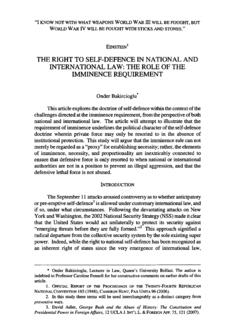Transcription of Food, Self and Identity - Oglethorpe University
1 See discussions, stats, and author profiles for this publication at: Food, self and Identity ARTICLE in SOCIAL SCIENCE INFORMATION MAY 1988. Impact Factor: DOI: CITATIONS READS. 252 6,856. 1 AUTHOR: Claude Fischler French National Centre for Scientific Researc . 82 PUBLICATIONS 1,381 CITATIONS. SEE PROFILE. Available from: Claude Fischler Retrieved on: 02 November 2015. Fischler, Claude, 1988. "Food, self and Identity ." Social Science Information 27:275-293. Food, self and Identity Claude Fischler Food is central to our sense of Identity . The way any given human group eats helps it assert its diversity, hierarchy and organisation, but also, at the same time, both its oneness and the otherness of whoever eats differently.
2 Food is also central to individual Identity , in that any given human individual is constructed, biologically, psychologically and socially by the foods he/she choses to incorporate. This paper is intended as a speculative survey of the ways in which food is related to Identity formation*. The approach it adopts, however, is based on the realization that the human relationship to food obviously is a complex one. It combines at least two different dimensions. The first runs from the biological to the cultural, from the nutritional function to the symbolic function.
3 The second links the individual to the collective, the psychological to the social. Yet a rapid overview of the abundant literature on human food suggests that few of the salient works on the subject have directly addressed this multi-dimensional character. After long neglecting the area of food and eating, the social sciences first and quite naturally concerned themselves with analysis of practices and collective representations. Claude L vi- Strauss (1968) and Mary Douglas (1966 ; 1979) focussed on the networks of meanings underlying cultures and cuisines.
4 Sociologists of culture (Grignon & Grignon, 1980 ; Bourdieu, 1979) analyse the social norms governing eating and work at showing that "tastes" can be understood as socially constructed and differentiated, normative sets of practices ("popular" taste, "bourgeois" taste, etc.). Other works are concerned with the social and cultural conditions for emergence of elaborate forms of culinary art (Goody, 1982). With a few exceptions, in particular that of Audrey Richards in the 1930s (Richards, 1932 ; 1939), the social sciences have rarely if ever tried to relate meanings and practices to biological constraints or determinisms.
5 Meanwhile, researchers in experimental psychology, physiology, physical anthropology and nutrition were busy analysing the human relationship to food in terms of behaviour, metabolic regulation, nutritional requirements. What the social scientists saw as "practices", they thought of as "behaviour". Where sociologists or anthropologists spoke of "representations" or "meanings", they saw "wants" and "beliefs". Any given eating practice tended to be assessed in terms of its consistency with nutritional "needs". Thus, any "habit" deemed sound in those terms was seen as an instance of "wisdom of the body", while dietary traits devoid of any visible biological relevance or "counter-productive" were described in often judgmental terms as "irrational prejudice", "superstitions" or ultimately manifestations of "ignorance".
6 *. An earlier version of this paper was published in French with the title "Alimentation, cuisine et identit : l'identification des aliments et l'identit du mangeur", Recherches et travaux de l'Institut d'ethnologie, University of Neuch tel (Switzerland), 6, 1985, 171-192. 1988. "Food, self and Identity ." Social Science Information 27:275-293. In the view of the "hard" sciences, anthropology, social psychology and sociology could be put to only one, practical, use: help nutrition and medicine rationalise food habits, help shape wants in accordance to "scientifically" defined needs.
7 At the time of World War II, the US government typically set up a "Committee on Food Habits" composed of social scientists. Its stated purpose was to "get people to wish what they need". Defining the "needs" was the task of another committee, the Food and Nutrition Board (Spang, in press). Thus, on either side, the "Great Wall" between the social and the natural sciences (Morin, 1973). remained the sole horizon of knowledge and inquiry. The biologists and behavioural scientists showed little interest in the fact that in Homo sapiens food not only nourishes but also signifies.
8 They scarcely noticed that human organisms are conscious and that they share representations. The sociologists and ethnologists, on the other hand, rightly endeavoured to show that biological organisms and individuals are immersed in, and constructed by, social forces. But conversely, following the Durkheimian principle that the social can only be explained in social terms and complying to the authority of cultural relativism, they no doubt often failed to consider that groups and societies are made up of individuals generally endowed with a biological As a consequence, on both sides certain "naive" yet fundamental questions have been little addressed, if at all: How do organisms and representations, biological individuals and their culture, interact with each other and with their environment?
9 How do socially constructed norms and representations become internalized - inscribed, so to speak, in taste-buds and metabolisms? Do not these norms and representations also have a biological side? How do they tie into the ecosystems in which subjects and societies experience them? How do they reproduce and/or modify themselves? And first of all, how are they constituted? I would like to demonstrate here that it does seem legitimate to address the question of the relationship between Identity and food from such a point of view. Major theoretical problems are raised, if only because the notion of Identity is itself somewhat problematic.
10 Without tackling these problems directly, and without for a moment claiming to resolve the whole set of questions that is raised, I shall simply try to adopt an "integrative" approach, integrative in the sense that there is a need to bring together the scattered images of biological man and social man. To endeavour to clarify how and why food is so closely linked to Identity , one first needs to recall certain basic characteristics of Homo sapiens' relationship to his/her food in its multidimensional character - behavioural and cognitive, psychological and cultural, individual and collective.







